MOBILITY V’S FLEXIBILITY
Before we explore ‘everyday mobility’, let's have a look at what mobility is; the difference between mobility v’s flexibility; and where stability fits into the equation. Mobility is our ability to move a body part or joint with control, without force (also called active range of movement – AROM). Whereas flexibility is our ability to move a body part or joint to its full range of movement without control, with the aid of force or gravity (passive range of movement – PROM). Lastly, stability is our ability to resist against forces and keep the body part or joint stable in static poses or transitions. Mobility increases tissue health, while excessive flexibility causes connective tissue deterioration. Flexibility does have its place, if there are areas of tightness it will help to recapture good mobility by gently working into flexibility first. Often what we are striving for is a small difference between the extent of your passive movement (flexibility) and your active movement (mobility). If the gap is too wide it means that you have good flexibility but not enough muscle control to protect the joints and muscles in their extended position.
EVERYDAY MOBILITY
Adding another layer to that equation, what is ‘everyday’ mobility? Everyday mobility is our ability to move a body part or joint within the range of movement that you, as an individual, require in your everyday life – ranging from easily getting up from a seated position to enjoying your sporting endeavours. To move fluidly in your everyday life your mobility is not dependent on being able to wrap your leg around your head or hold a handstand for 10 minutes. When you are striving for a ‘big pose’ in your practice, ask yourself if this pose serves me in my everyday life, what will I benefit from achieving this shape? Instead, concentrate on building a variety of movements into your practice as your goal, and actively mobilising all your body parts or joints with stability and control.
EXPLORING EVERYDAY MOBILITY IN YOUR PRACTICE
This sequence starts with a warm up that will move your spine, hips and shoulders. Take your time and focus on these three areas as you flow. The two standing flows start with some core work and bring you through a series of mini flows that all start from my current favourite pose, Viparita Virabhadrasana/Reverse Warrior. Remember that in Viparita Virabhadrasana/Reverse Warrior the hips stay level and the spine facilitates the side bend, whereas in Trikonasana/Triangle the pelvis tilt over the front leg with minimum side bending in the spine. Pay particular attention to your transitions in this sequence. Move slowly and focus on stability and control in your main joints – your knees, hips, spine and shoulders.
ALIGNMENT CUES
There is no specific peak pose in this everyday mobility sequence. Use the cues below to help you flow through the sequence with ease and fluidity.
Have a read of the tips below and either print out the sequence or save it onto your device:
Use the breath guide in the sequence to help you link breath with movement in the flow. Inhale is indicated with a ‘+’, exhale is a ‘-”.
If there are specific poses that you would like to stay longer in, give yourself three deep breaths in those poses and pick up the next pose with the allocated inhale or exhale as indicated by the sequence.
For a longer practice repeat the warm up flow on the first line at the start of each of the three standing flows or repeat each of the standing mini flows three times.
To save the images for personal use click and hold down the image until the ‘save image’ option appears; on Mac hold down ‘control’ and click the image to get the option box; on PC right click on the image to get the option box. Scroll down in the ‘option box’ and click ‘save image’.
Ruth Delahunty Yogaru





